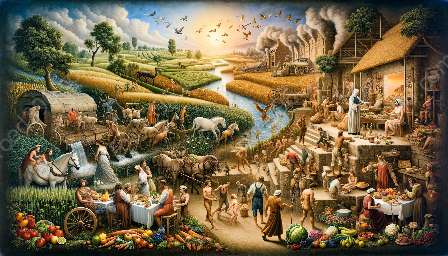Climate plays a significant role in shaping food production and agriculture, impacting historical developments and contributing to the rich tapestry of food culture and history.
Understanding the Influence of Climate
The influence of climate on food production is profound and multifaceted. Various climatic factors such as temperature, precipitation, and humidity directly affect the growth and productivity of crops and livestock.
Temperature: Temperature variations impact plant growth, flowering, fruit set, and ripening. Different crops have specific temperature requirements for optimal growth.
Precipitation: Adequate and timely rainfall is crucial for crop development, while excessive rain can lead to waterlogging and crop damage. Conversely, drought conditions can result in yield losses and affect food production.
Humidity: High humidity levels can foster the growth of pathogens and pests, affecting crop health and productivity.
Historical Developments in Food Production and Agriculture
The influence of climate on food production has been evident throughout history. Early agricultural practices were deeply intertwined with local climate and environmental conditions. Crops and livestock were selected based on their adaptability to the prevailing climate, leading to the development of region-specific agricultural systems.
Historical shifts in food production and agriculture were often driven by changes in climate patterns. For example, the agricultural practices of ancient civilizations such as the Sumerians and Egyptians were shaped by the fertile soils and favorable climate of river valleys, leading to the emergence of advanced irrigation systems and agricultural techniques.
Furthermore, climatic events such as droughts or sudden temperature changes have had significant impacts on historical food production. These events often led to societal upheaval, migrations, and adaptations in agricultural practices to cope with adverse climatic conditions.
Food Culture and History
The influence of climate on food production has profoundly affected food culture and history. Local climates have given rise to diverse culinary traditions and cuisines, with regional dishes often reflecting the available local produce and agricultural practices.
Traditional farming methods and food preservation techniques were developed in response to specific climate and environmental conditions. For example, the practice of fermenting foods for preservation emerged as a way to ensure a stable food supply in regions prone to long, harsh winters.
The impact of climate extends beyond traditional agriculture, shaping global food trade and the spread of culinary traditions. Historical trade routes and exploration efforts were driven by the quest for access to new food sources and spices, often influenced by favorable climates for specific crops.
The Complex Relationship between Climate and Food Production
The relationship between climate and food production is complex and dynamic. Climate change poses significant challenges to food security and agricultural sustainability, highlighting the vulnerability of food production systems to shifting climatic patterns.
Understanding the influence of climate on food production is essential for developing resilient agricultural practices and adaptive strategies. Advances in agricultural technology and research can help mitigate the impacts of climate on food production through the development of climate-resilient crop varieties, efficient water management systems, and sustainable farming practices.
By recognizing the influence of climate on food production and its historical significance, we can better appreciate the intricate connections between agriculture, food culture, and the natural environment.

